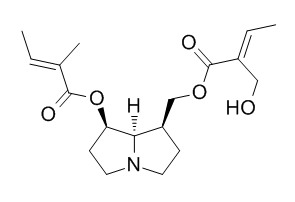Neosarranicine
Neosarranicine is a natural product from Senecio serra.
Inquire / Order:
manager@chemfaces.com
Technical Inquiries:
service@chemfaces.com
Tel:
+86-27-84237783
Fax:
+86-27-84254680
Address:
1 Building, No. 83, CheCheng Rd., Wuhan Economic and Technological Development Zone, Wuhan, Hubei 430056, PRC
Providing storage is as stated on the product vial and the vial is kept tightly sealed, the product can be stored for up to
24 months(2-8C).
Wherever possible, you should prepare and use solutions on the same day. However, if you need to make up stock solutions in advance, we recommend that you store the solution as aliquots in tightly sealed vials at -20C. Generally, these will be useable for up to two weeks. Before use, and prior to opening the vial we recommend that you allow your product to equilibrate to room temperature for at least 1 hour.
Need more advice on solubility, usage and handling? Please email to: service@chemfaces.com
The packaging of the product may have turned upside down during transportation, resulting in the natural compounds adhering to the neck or cap of the vial. take the vial out of its packaging and gently shake to let the compounds fall to the bottom of the vial. for liquid products, centrifuge at 200-500 RPM to gather the liquid at the bottom of the vial. try to avoid loss or contamination during handling.
Industrial Crops and Products2024, 129:119014
Naunyn Schmiedebergs Arch Pharmacol.2021, 394(1):107-115.
Plant Sci.2021, 313:111069.
J Sci Food Agric.2017, 97(5):1656-1662
J Cell Mol Med.2023, jcmm.17968.
Cancer Sci.2022, 113(4):1406-1416.
Molecules.2018, 23(11):E2837
J Applied Biological Chemistry2021, 64(2):185-192
Molecules.2024, 29(17):4034.
Bulletin of Health Research2016, 44(4):279-286
Related and Featured Products
Rhodes University,1996.
The pyrrolizidine alkaloids of Senecio chrysocoma and Senecio paniculatus[Reference:
WebLink]
In order to compare the pyrrolizidine alkaloid content of two closely related species, Senecio chrysocoma and S. paniculatus, nine populations of plants distributed between the two species, were examined.
METHODS AND RESULTS:
Three novel pyrrolizidine alkaloids, 7ß-angelyl-l-methylene-8∝-pyrrolizidine, 7ß-angelyl-l-methylene-8∝-pyrrolizidine and 7ß-angelyl-l-methyleneSO!-pyrrolizidine-4-oxide, as well as eight known pyrrolizidine alkaloids, 7-angelylhastanecine, 9-angelylhastanecine, 7-angelylplatynecine, 9-angelylplatynecine, 9-angelylplatynecine-4-oxide, sarracine, neosarracine and retrorsine, were isolated and identified by NMR and GC-MS techniques. Traces of five tiglyl isomers, 9-tiglylplatynecine, 9-tigl ylplatynecine-4-oxide, 7ß-tiglyl-l-methylene-8∝-pyrrolizidine, sarranicine and Neosarranicine, were also isolated and tentatively identified; however, these compounds could have been artefacts of the extraction and analytical procedures.



